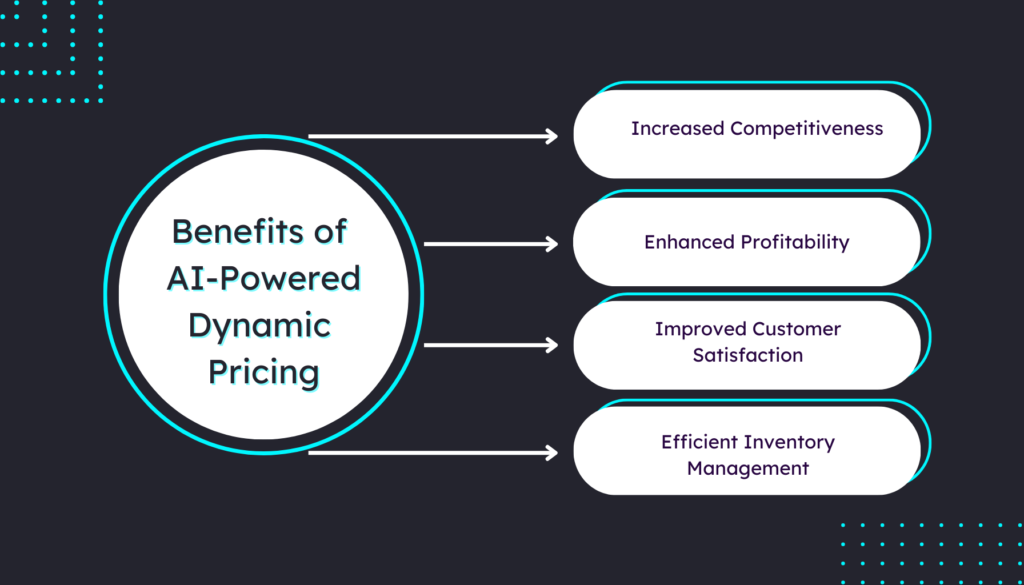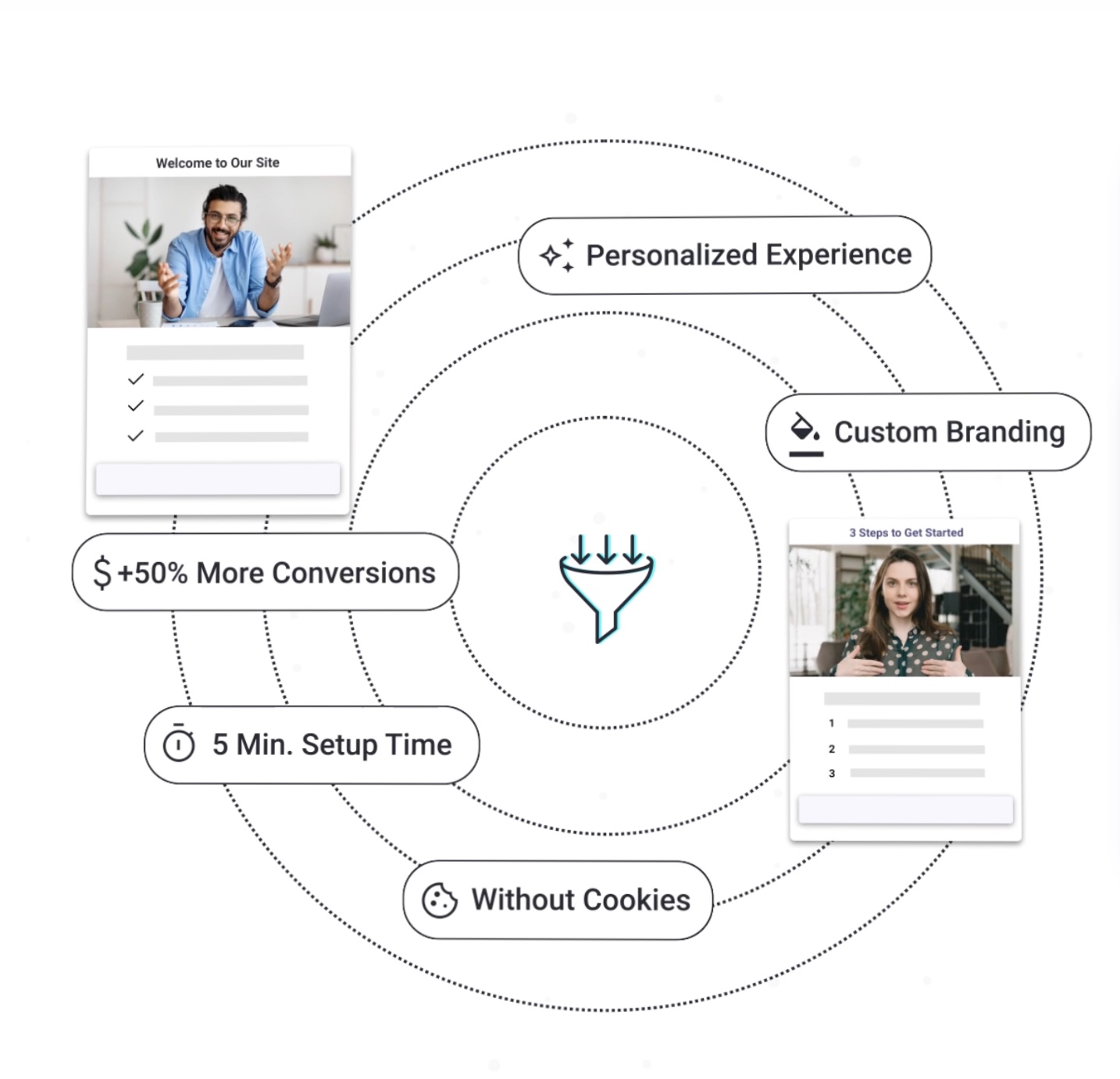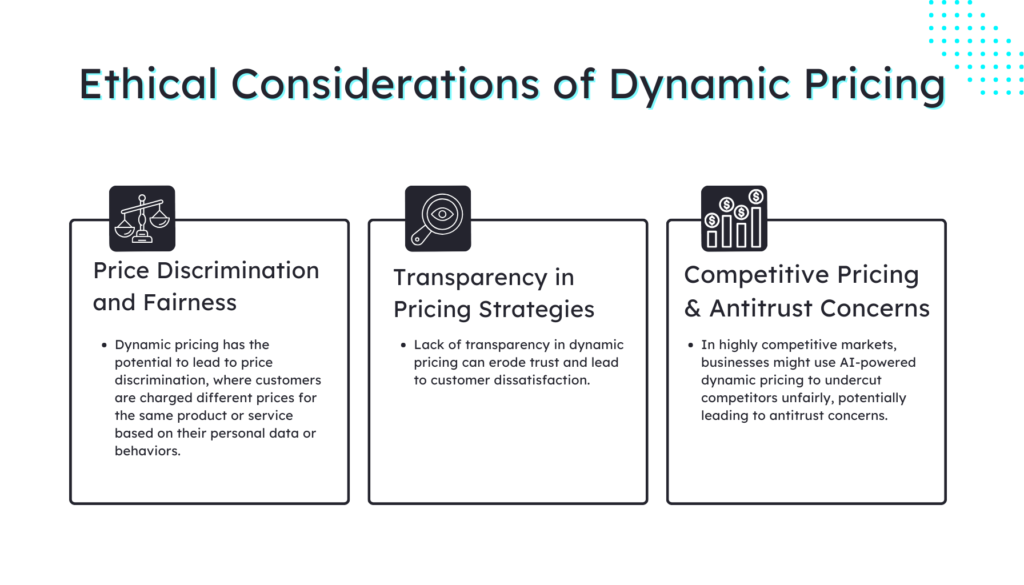The Future of E-commerce: Dynamic Pricing Strategies Powered by AI


Staying competitive and profitable has become a constant challenge in the e-commerce industry. As consumer behavior shifts, market dynamics change, and competitors innovate, businesses need dynamic solutions to meet these challenges head-on. This is where the synergy of artificial intelligence (AI) and dynamic pricing strategies intersect, promising a future for e-commerce that’s more adaptive and lucrative than ever before.
E-commerce has transformed the way we shop, offering unparalleled convenience and access to a vast array of products and services. However, this digital revolution has also ushered in intense competition, with thousands of online retailers vying for the attention and wallets of consumers. In such a landscape, traditional pricing strategies that remain static can no longer suffice. Today’s consumers expect not only competitive prices but also personalized, real-time offers tailored to their preferences.
In this blog post, we’ll embark on a journey into the future of e-commerce, where dynamic pricing strategies, supercharged by AI, are reshaping the industry landscape. We will delve deep into the principles, benefits, and real-world applications of AI-driven dynamic pricing, shedding light on how it empowers businesses to thrive in the digital age.
Understanding Dynamic Pricing
At its core, dynamic pricing is a pricing strategy that allows you to flexibly adjust the prices of your products or services in response to changing market conditions, demand fluctuations, and various external factors. Unlike fixed pricing, where prices remain constant, dynamic pricing involves continuous monitoring and adaptation of prices to maximize revenue, profit, or achieve other specific business objectives.
This adaptive approach to pricing is not a new concept; however, what sets modern dynamic pricing apart is its reliance on cutting-edge AI technologies. AI algorithms process vast amounts of data, including competitor pricing, historical sales data, real-time demand signals, and even individual customer behavior, to make informed pricing decisions. This ensures that prices remain competitive, relevant, and optimized in a rapidly changing market environment.
Traditional pricing strategies, while effective in certain scenarios, often fall short in today’s dynamic e-commerce landscape. Some common traditional pricing approaches include:
- Cost-Plus Pricing: Determining prices by adding a fixed markup to production costs.
- Competitor-Based Pricing: Setting prices based on what competitors charge for similar products.
- Fixed Pricing: Keeping prices constant over time, regardless of market changes.
While these strategies have their merits, they come with notable limitations:
- Lack of Responsiveness: Fixed pricing strategies can’t adapt to sudden market shifts or changing customer preferences, potentially resulting in lost revenue opportunities.
- Inefficient Inventory Management: Without real-time pricing adjustments, businesses may struggle to optimize inventory levels and minimize overstock or stockouts.
- Inability to Optimize Margins: Traditional methods often neglect to maximize profit margins by pricing products at the highest price point consumers are willing to pay.
The Role of AI in Dynamic Pricing
AI, particularly through machine learning algorithms, possesses remarkable capabilities that make it indispensable for pricing optimization in e-commerce:
- Pattern Recognition: AI algorithms can identify complex patterns in vast datasets, uncovering valuable insights into customer behavior, market trends, and demand fluctuations.
- Continuous Learning: Machine learning models are not static; they adapt and learn from new data, ensuring that pricing strategies evolve with changing market conditions.
- Predictive Analytics: AI can forecast future demand, helping you proactively adjust prices to meet customer expectations and revenue goals.
- Automation: AI-driven dynamic pricing is automated and can operate 24/7, providing you with a competitive advantage in responding to market changes in real time.
How AI Algorithms Analyze Data for Real-Time Pricing Decisions
AI algorithms analyze an array of data sources to make real-time pricing decisions that maximize revenue and align with business objectives:
- Market Data: AI scans the market to monitor competitor pricing, ensuring your prices remain competitive.
- Historical Data: Past sales data helps identify trends and seasonality, allowing for informed pricing adjustments.
- Customer Data: Individual customer behavior and preferences are considered to personalize pricing and promotions.
- Demand Signals: Real-time demand signals, such as website traffic and product searches, inform pricing decisions to meet immediate market needs.
AI processes this data rapidly and can adapt pricing strategies at speed and scale that would be impossible for human pricing teams to achieve manually.

Benefits of AI-Powered Dynamic Pricing
AI-powered dynamic pricing has emerged as a game-changer for e-commerce businesses, offering a range of advantages that translate into increased competitiveness, enhanced profitability, improved customer satisfaction, and efficient inventory management.
- Increased Competitiveness
AI-powered dynamic pricing provides e-commerce businesses with a competitive edge in several ways:
- Real-Time Pricing Adjustments: You can respond instantly to changes in the competitive landscape. AI algorithms analyze competitor pricing and adjust prices accordingly, ensuring that your offerings are always competitive.
- Market Expansion: By optimizing pricing for different segments of your target market, AI helps you tap into previously untapped customer segments, expanding your customer base and reach.
- Price Testing: AI allows for sophisticated price testing. You can experiment with different pricing strategies and gauge their impact on sales and profitability, enabling data-driven decision-making.
- Enhanced Profitability
AI-driven dynamic pricing has a direct impact on a business’s bottom line:
- Maximized Margins: AI algorithms calculate optimal prices that maximize profit margins. This precision ensures that you aren’t leaving money on the table.
- Revenue Optimization: Through continuous price adjustments based on demand and market conditions, AI helps maximize revenue potential, especially during peak demand periods or promotions.
- Cost Reduction: Efficient pricing strategies can also help reduce costs associated with unsold inventory or overstocking, further contributing to profitability.
- Improved Customer Satisfaction
Satisfied customers are more likely to become repeat buyers and brand advocates. AI-powered dynamic pricing plays a crucial role in enhancing customer satisfaction:
Personalization: By analyzing individual customer behavior and preferences, AI tailors pricing and promotions to each customer, creating a personalized shopping experience.
More Sales From Your Website With AI
Personalized interactions based on your users' behaviour to get +50% more conversions.

- Competitive Pricing: Customers appreciate fair and competitive pricing. AI ensures that prices are aligned with market rates, instilling confidence in the fairness of your pricing strategies.
- Consistency: AI-driven pricing is consistent and reliable, reducing the likelihood of pricing errors that can lead to customer frustration.
- Efficient Inventory Management
Efficient inventory management is essential for e-commerce businesses to minimize costs and maximize profits. AI-powered dynamic pricing contributes to this efficiency:
- Inventory Optimization: AI analyzes demand patterns and adjusts prices to help manage inventory levels effectively. This reduces the risk of stockouts and overstock situations.
- Clearance of Slow-Moving Items: AI can identify slow-moving or excess inventory and recommend pricing strategies to clear these items, preventing them from becoming a burden on your inventory.
- Reduction in Holding Costs: By optimizing inventory turnover, AI helps reduce holding costs associated with storing excess inventory for extended periods.
AI Algorithms for Dynamic Pricing
1. Price Optimization Algorithms
Price optimization algorithms are at the heart of AI-driven dynamic pricing. They aim to find the optimal price point for a product or service that maximizes revenue, profit margins, or other defined business objectives.
Example: Suppose an e-commerce business sells a popular consumer electronics product. Price optimization algorithms analyze historical sales data, competitor pricing, and current demand trends. They may find that during the holiday seasons, demand for this product significantly increases. The algorithm adjusts the price upward during these periods to capture additional revenue while keeping prices competitive.
2. Demand Forecasting Models
Demand forecasting models use historical and real-time data to predict future demand for products or services. These predictions help you plan pricing strategies that align with expected market conditions.
Example: A clothing retailer leverages demand forecasting models to anticipate seasonal trends. As winter approaches, the algorithm predicts a surge in demand for winter coats. The retailer adjusts prices upward for coats to maximize profitability during this period.
3. Competitive Pricing Analysis
Competitive pricing analysis tools monitor and analyze competitor pricing data. They provide insights into how competitors are pricing similar products, helping you make informed pricing decisions.
Example: A hotel chain uses competitive pricing analysis to monitor the rates of nearby hotels. When it detects that a competitor is offering lower prices for rooms during a particular weekend, the hotel adjusts its prices to remain competitive while still maintaining profitability.
Success Stories of AI Algorithms in Action in E-commerce
To truly understand the power of AI-powered dynamic pricing in e-commerce, let’s explore real-world examples of businesses that have successfully harnessed this technology to achieve remarkable results. We’ll showcase how AI-driven dynamic pricing strategies have impacted revenue, sales, and customer engagement.
1. Case Study: Amazon
Background: Amazon, the global e-commerce giant, uses AI extensively for dynamic pricing. Its algorithms consider various factors, including competitor pricing, demand trends, and historical data.
Impact:
- Revenue: Amazon’s AI-driven dynamic pricing contributes significantly to its annual revenue. During peak shopping seasons like Black Friday and Cyber Monday, the platform maximizes profitability by optimizing prices in real time.
- Sales: By adjusting prices based on consumer demand and competitor pricing, Amazon keeps its sales figures consistently high, even during non-peak periods.
- Customer Engagement: Personalized recommendations and pricing adjustments based on individual browsing and shopping behavior enhance customer engagement. Customers are more likely to return to Amazon for their shopping needs due to the platform’s competitive and responsive pricing.
2. Case Study: Walmart
Background: Walmart, one of the world’s largest retailers, employs AI-driven dynamic pricing to enhance its e-commerce platform.
Impact:
- Revenue: By continuously adjusting prices based on real-time demand, competitor pricing, and seasonal trends, Walmart maximizes revenue across its extensive product range. The company also leverages dynamic pricing during major shopping events like Black Friday.
- Sales: Walmart’s dynamic pricing strategy ensures that products remain competitively priced, attracting a larger customer base and increasing sales volumes. The platform adapts to sudden spikes in demand for specific items.
- Customer Engagement: Personalized pricing and tailored promotions engage customers by offering relevant discounts and incentives. This keeps shoppers returning to Walmart’s e-commerce platform for their shopping needs.
3. Case Study: Airline Industry
Background: Airlines have long used demand forecasting models to set ticket prices. These models consider factors like booking lead times, route popularity, and historical demand.
Impact:
- Revenue: Airlines maximize revenue by adjusting ticket prices based on demand. This approach ensures that airlines capture the highest possible fares, especially for last-minute bookings.
- Sales: Airlines maintain a consistent flow of passengers by offering competitive fares. Passengers are more likely to choose a specific airline if it offers competitive pricing and a convenient schedule.
- Customer Engagement: While customers appreciate competitive pricing, airlines also use AI to personalize offers, such as seat upgrades and travel packages, which enhance the overall customer experience.

Ethical Considerations of Dynamic Pricing
While AI-driven dynamic pricing offers significant advantages for e-commerce businesses, it also raises important ethical considerations related to fairness, price discrimination, and transparency.
1. Price Discrimination and Fairness
Dynamic pricing has the potential to lead to price discrimination, where customers are charged different prices for the same product or service based on their personal data or behaviors. This practice can be perceived as unfair and discriminatory.
Solution:
- Transparency: You always should strive for transparency in your pricing strategies. Clearly communicate to customers how prices are determined, including the use of personal data or browsing history to tailor offers. Transparency builds trust and helps customers understand why they may see different prices.
- Avoidance of Unjust Discrimination: Implement policies and guidelines to avoid unjust discrimination. Ensure that pricing adjustments are based on legitimate factors, such as supply and demand, rather than sensitive customer attributes like race, gender, or socioeconomic status.
- Customer Options: Offer customers options to control the level of personalization they receive. Allow them to opt out of data-driven pricing adjustments if they prefer fixed or non-personalized pricing.
2. Transparency in Pricing Strategies
Lack of transparency in dynamic pricing can erode trust and lead to customer dissatisfaction.
Solution:
- Clear Communication: Clearly communicate pricing changes and factors affecting those changes to customers. Use plain language to explain how dynamic pricing works and why it benefits both the business and the customer.
- Price History: Provide customers with access to their price history and the ability to review past purchases and prices. This empowers customers to make informed decisions and identify patterns.
- Privacy Protection: Safeguard customer data and adhere to privacy regulations. Assure customers that their personal information is used responsibly and only for legitimate purposes.
3. Competitive Pricing and Antitrust Concerns
In highly competitive markets, businesses might use AI-powered dynamic pricing to undercut competitors unfairly, potentially leading to antitrust concerns.
Solution:
- Compliance with Regulations: Ensure that dynamic pricing strategies comply with antitrust laws and regulations in your region. Seek legal counsel if needed to assess the fairness and legality of pricing practices.
- Ethical Business Practices: Focus on ethical competition rather than exploiting pricing algorithms solely for competitive advantage. Balance the desire for profitability with ethical considerations.
Conclusion
As we stand at the crossroads of commerce and technology, the integration of AI-driven dynamic pricing heralds a new era for e-commerce. The power to adapt prices in real-time, anticipate customer needs, and optimize revenue streams is at our fingertips. Yet, with this immense power comes an equally significant responsibility.
In the realm of dynamic pricing, ethical considerations must guide our path forward. Price discrimination, transparency, and competitive fairness demand our utmost attention. How we leverage this technology speaks volumes about our commitment to fairness and customer-centric values.
As you embrace the potential of AI-powered dynamic pricing, do so with a conscious commitment to uphold the highest standards of fairness and transparency.





